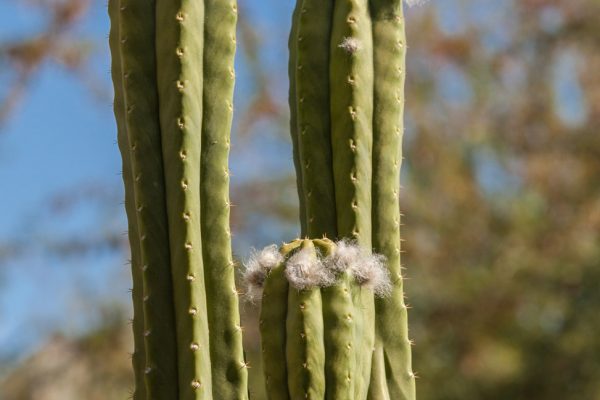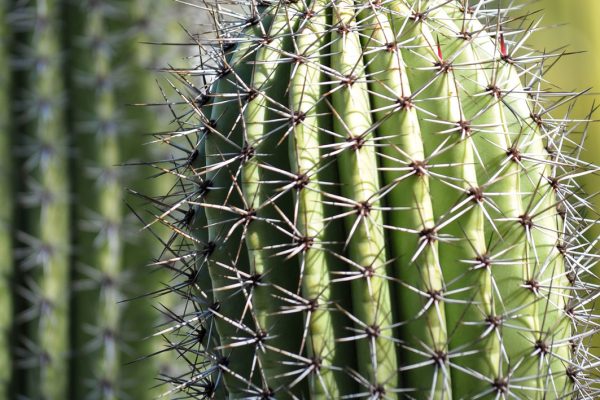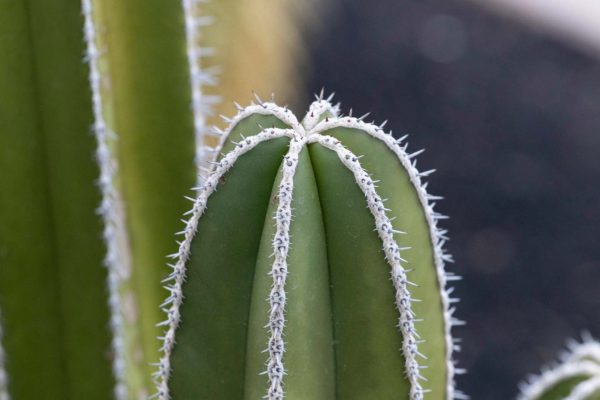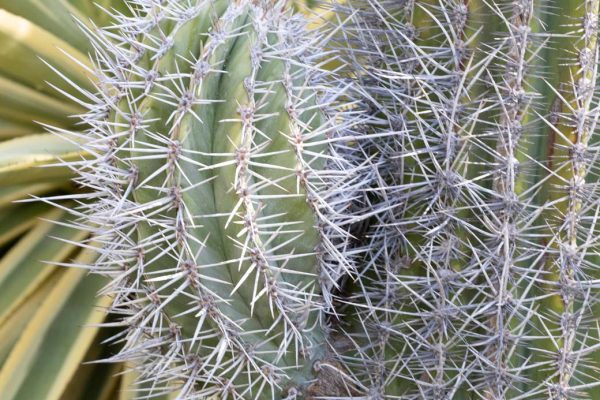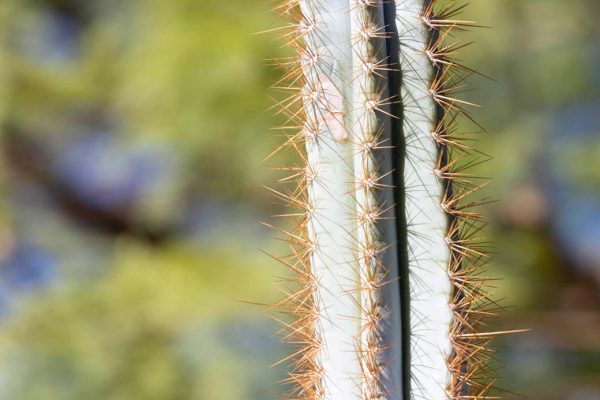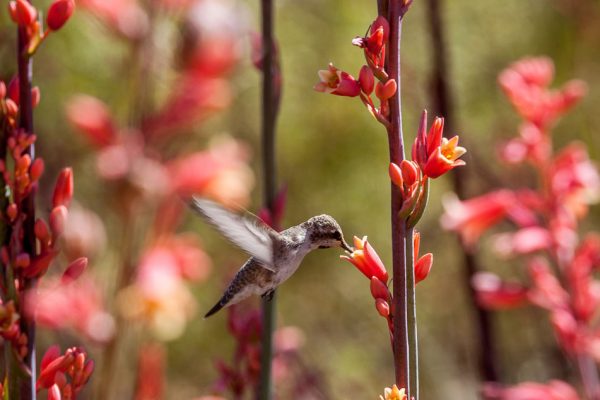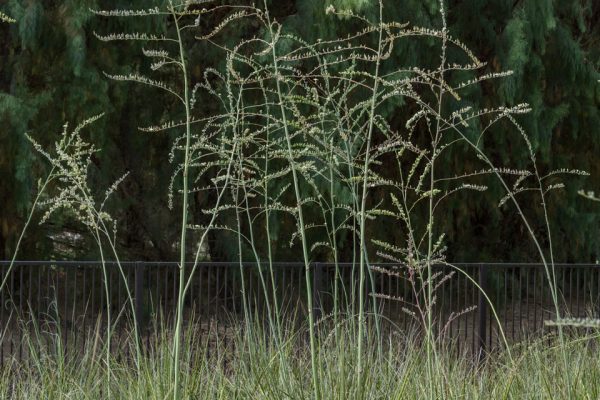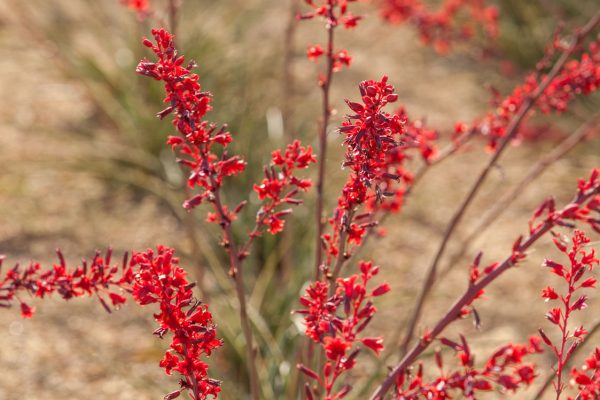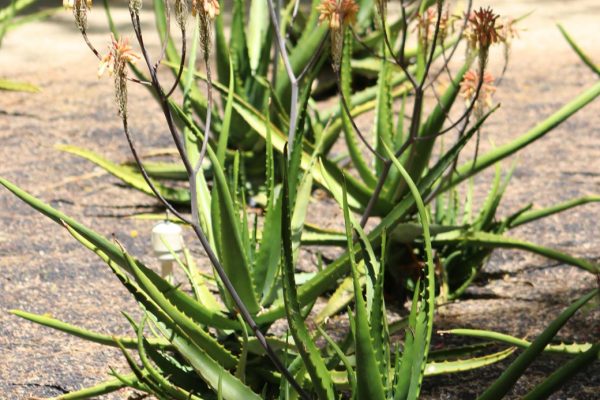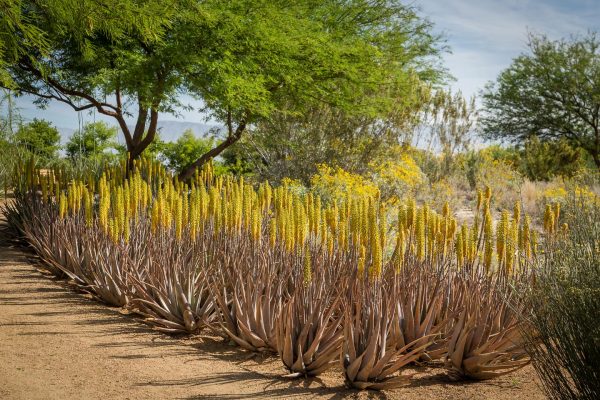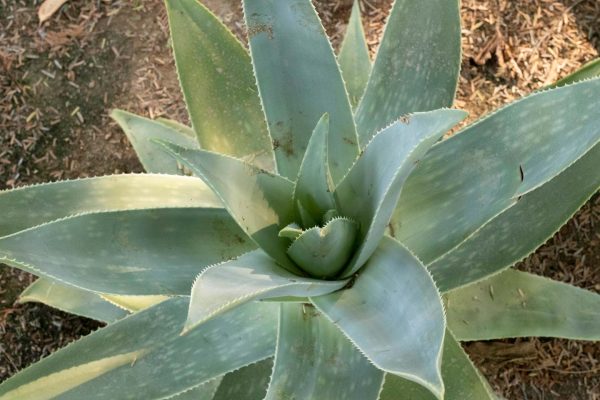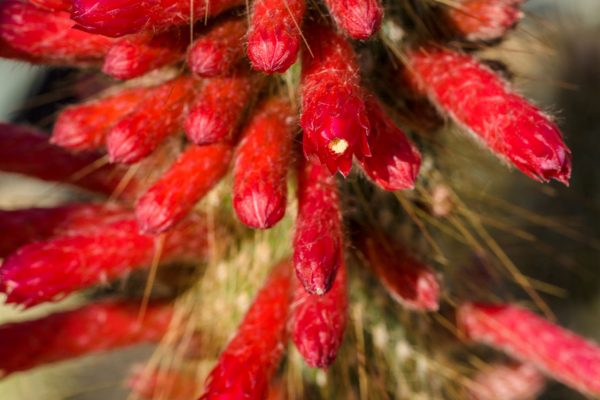
The specimen beds near the café have several Silver Torch cacti. The original planting included the species strausii, but clearly there are some other varieties from within the genus, and possible hybrids displaying a range of bloom color and spine distribution.
Silver Torch displays an abundance of spines on thin, cylindrical stems. It grows to about 10 feet. In the botanical genetics field, there is still some disagreement as to what should be included in the Cleistocactus genus, so as cactus are sorted more specifically along genetic lines rather than botanist observations, we will see new groupings in the future.
Red blooms can occur on Silver Torch Cactus throughout the year. At Sunnylands, the blooms emerge between red and orange, but generally the plant can flower with yellow and green blooms, too. The flowers barely open, and it is from this they get the name of the genus, Cleistocactus, as Kleisto in Greek means, “closed.” This tightly wrapped bloom may show some diversity, growing both straight and curved on different species. The blooms have a beak shape that closely accommodates the beaks of the hummingbirds that pollinate them. Birds with larger beaks would have difficulty. Flower design clearly shows preference when it comes to pollinators. In this case, it’s the hummingbirds that are preferred.
The genus of Cleistocactus extends throughout Argentina, Peru, and Bolivia.
San Pedro is planted throughout the gardens. You can see it in the specimen beds, in spotlight beds around the wildflower field, and the lower garden path. This is a columnar variety with very small spines spaced along the rib margins. In some cases, the spines are completely absent. Native at much higher elevations than Sunnylands, it nevertheless seems to thrive on the desert floor, as it is one of our most prolific bloomers.
The fragrant, white blooms open at night to await the nocturnal pollinators, bats, and moths.
The large, funnel-shaped blooms remain open the next morning, finding themselves the host of native bees who are completely engulfed by the long, pollen-covered stamens. The bees disappear into the bloom and re-emerge, speckled yellow.
San Pedro is native to Ecuador and Peru, where it is used extensively by indigenous cultures for medicine.

In the specimen beds between the café and the solar field, you will find the columnar Organ Pipe cactus. There are three in the bed closest to the café. Their flesh is dark green with red spines at the crown that turn gray down the column.
Another night-blooming giant, the Organ Pipe’s numerous branches can reach up to 26 feet. Its flowers are funnel-shaped and a pale cream color. The blooms open at night dispersing the scent of nectar that attracts moths and bats. Some come for the nectar and others for fruit—both exist simultaneously as the bloom period progresses. Insectivore species of Pallid Bat can be found hunting the pollinating moths foraging within the fruit. By late morning, the blooms close and the diurnal pollinators move in to take their turn as the day heats up and the fruits begin to ferment.
Distribution in Mexico includes Sonora, Baja California Sur, and Sinaloa. Arizona hosts the only wild range of this cactus in the United States, where it is designated as a national monument and UNESCO biosphere reserve.
This columnar cactus is in the specimen beds nearest the shuttle gate. It is easy to identify with the solid white margin along ribs that display its spines.
Like the Cardon cactus, Fencepost is part of the Pachycereus genus. The common name of Fencepost references its cultivation to create living fences. With a maximum height around 16 feet, it does make a formidable barrier when placed close together.
Mature specimens bloom red, funnel-shaped flowers with pink interiors in rows down the rib margins.
Fencepost’s distribution is in Mexico, and includes the states of Hidalgo, Guanajuato, Querétaro, Morelos, Puebla, Oaxaca, Colima, Michoacán, and Guerrero.

Cardon can grow to 36 feet, and its spines are gray to white. There are three Cardon in the specimen beds nearest the solar field. They are still quite young and were less than 5 feet tall when planted during the original installation.
The Cardon is part of a family that consists of over 12 other large columnar cactus species under the genus Pachycereus (Greek for “thick” and “torch”). These botanical groupings for cactus are a bit fragile, and more phylogenic (genetic tracing) work needs to be completed. Not all cactus have had their genetic connections confirmed. In some groupings, they do not share the same taxonomic features and may later be determined to be unrelated. For now, they are grouped based on similar size and their candelabra structure. There are three species in the gardens that fall into this genus: Cardon, Fencepost, and Totem Pole.
When mature, they will display funnel-shaped, white flowers that will bloom both day and night, attracting multiple pollinators. This genus Pachycereus also has significant ethnobotanical uses by desert native cultures.
Distribution of Cardon includes the Sonoran Desert states of Sonora, Baja California, and Baja California Sur in Mexico. The Baja location is why it can be referred to as Baja Saguaro.
Blue Torch is in the specimen beds between the café and the solar field. A stunning columnar cactus, Blue Torch can range from a gray-blue to almost sea-foam blue in color. This species can grow to 20 feet, becoming tree-like with a center stalk and erect branches. Its golden spines will become gray with age.
The species azureus is synonymous with pachycladus, which is the name used in Edward F. Anderson’s 2004 edition of The Cactus Family.
The blooms of this genus are highly variable with some displayed as short and cup-shaped, and others reaching farther out to elongated bell-shapes. The bloom color is consistently creamy white.
The pachycladus is one of two distinct subspecies in Brazil, occurring in Bahia and Minas Gerais, south of the 10° south latitude. A similar cactus from the species pernambucoensis is found naturally in the northeast, north of the 10° south latitude.

Our medium-sized Hesperaloe is the extremely popular parviflora species, called Red Yucca or Hesperaloe. Due to its easily managed size and beautiful flowers, it is one of the most common Hesperaloes you will see in public garden spaces. Growing up to 4 feet, it develops curving marginal filaments that pull away from the leaf edge, giving the appearance of coarse hair growing off the edges. This makes it easy to distinguish from other rosette-forming succulents.
Red Hesperaloe grows a flowering stalk called a raceme. It can grow to a height of 9 feet, though at Sunnylands it grows normally between 6 and 7 feet, much lower than the 16 foot raceme of its cousin Giant Hesperaloe. Its blooms vary in color through natural garden cross-pollination and human cultivation, but they tend to stay in the dark red to coral pink ranges. This species is a parent of the smaller Hesperaloe called Brakelights, also planted at Sunnylands.
Hesperaloe in general appears to be popular with not only nectaring hummingbirds but also with opportunistic Monarch and Queen Butterfly caterpillars. When Hesperaloe is placed near milkweed beds, chrysalis of both butterflies have been found attached to its leaves. But chrysalis also has been found on agaves, so this is not an identifying feature.

The Giant Hesperaloe is the largest species of the genus Hesperaloe. This giant grows a rosette of crescent-like leaves that reach 6-feet high. For those not familiar with the differing desert genera that grow in a similar style, it can be difficult to distinguish them when not in bloom. Hesperaloe has one helpful indicator for identification, no this pattern is not exclusive to this genus, it helps identify it in these gardens. It is curving marginal filaments that pull away from the leaf edge, giving the appearance of coarse, white hair growing off the edges. If you see those, you then need to determine which species of Hesperaloe you are seeing in the gardens, which is easy. You simply determine, if it is in the 6 foot leaf range and if it is, you are probably looking at the Giant as there are only three species in the gardens, and they fall into the large, medium, and small categories.
Hesperaloe can expand by clumping additional tiny rosettes around the parent plant, as well as setting seed through flowering. They also readily cross-pollinate and hybridize. Giant Hesperaloe displays both pink and white blooming varieties, which grow on a flowering stalk called a raceme. The raceme can reach up to 16 feet. The creamy-white flower is associated with the original funifera species, but the other is a pinkish-toned hybrid. These are both pollinator favorites.
Hesperaloe in general appears to be popular with not only nectaring hummingbirds but also with opportunistic Monarch and Queen Butterfly caterpillars. When Hesperaloe is placed near milkweed beds, chrysalis of both butterflies have been found attached to its leaves. But chrysalis also has been found on agaves, so this is not an identifying feature.

Brakelights is the smallest of the Hesperaloe species at Sunnylands. The term [perpa] in its name means it is a copyrighted variety created through intentional cultivation. From this name, you can probably guess that it was cultivated to accentuate the deepest red variations that have occurred in the parviflora species.
Brakelights has a longer bloom period than its parviflora parent, which is possible because it does not set seed. The additional energy not used in the seed-setting processes allows it to extend its season. It blooms a deep red, but can be tinged with dark purple, making it incredibly striking to see in contrast to the lighter coral and cream blooms of its parent.
Hesperaloe in general appears to be popular with not only nectaring hummingbirds but also with opportunistic Monarch and Queen Butterfly caterpillars. When Hesperaloe is placed near milkweed beds, chrysalis of both butterflies have been found attached to its leaves. But chrysalis also has been found on agaves, so this is not an identifying feature.
The Nubian Aloe is another new addition to the gardens. It was added in 2016 to the northwest corner (the corner behind the Great Lawn closest to the solar field). Its leaves display a brighter green than other aloes in the garden.
Starting in January and continuing through the spring, blooms appear on a multi-branching stalk in colors closer to peach and apricot, not the reds and yellows of other aloes at Sunnylands. Like the Ghost Aloe, Nubian’s blooms appear bundled in clusters at the end of each branch. The blooms are a combination of yellow and peach tones, providing a softer appearance than other, more vibrant aloe cousins.
Nubian Aloe is indigenous to Ethiopia and Eritrea in Africa.
Groupings of Medicinal Aloes completely fill their planting beds throughout the gardens as they rapidly produce pups at their base. Growing to heights of 3 feet, their formal structure is effective as both an eye-catching backdrop for some smaller specimens and a front-and-center showstopper along other garden paths.
Medicinal Aloe is particularly striking from January through spring when it blooms in mass. Tall bayonets of yellow flowers create a frenzy of pollinator competition as bees and hummingbirds dodge each other to visit each bloom. The bloom stalks remain in place until all have completed their full cycle through seed setting—communicating that while the Sunnylands garden is an aesthetic garden, laid out with an artistic intent, it also embraces the natural process that allows each plant to complete its cycle.
The origin of Medicinal Aloe is the Arabian Peninsula, but today it is widely propagated around the world for both its aesthetic and medical qualities.
The Ghost Aloe is not a plant from the original landscape plan completed when Sunnylands opened in 2012, but its parent, the Coral Aloe is. Ghost Aloe is a smaller version of Coral Aloe with a tighter rosette. It’s less casual in its structure and has a frosty coloration that gives it the ethereal common name of Ghost.
The blooming structure of this Aloe is not a bayonet appearance like the Medicinal Aloe. It, like Coral Aloe, has a multi-branching stalk topped with a candelabra-type gathering of orange-red flower blooms.

